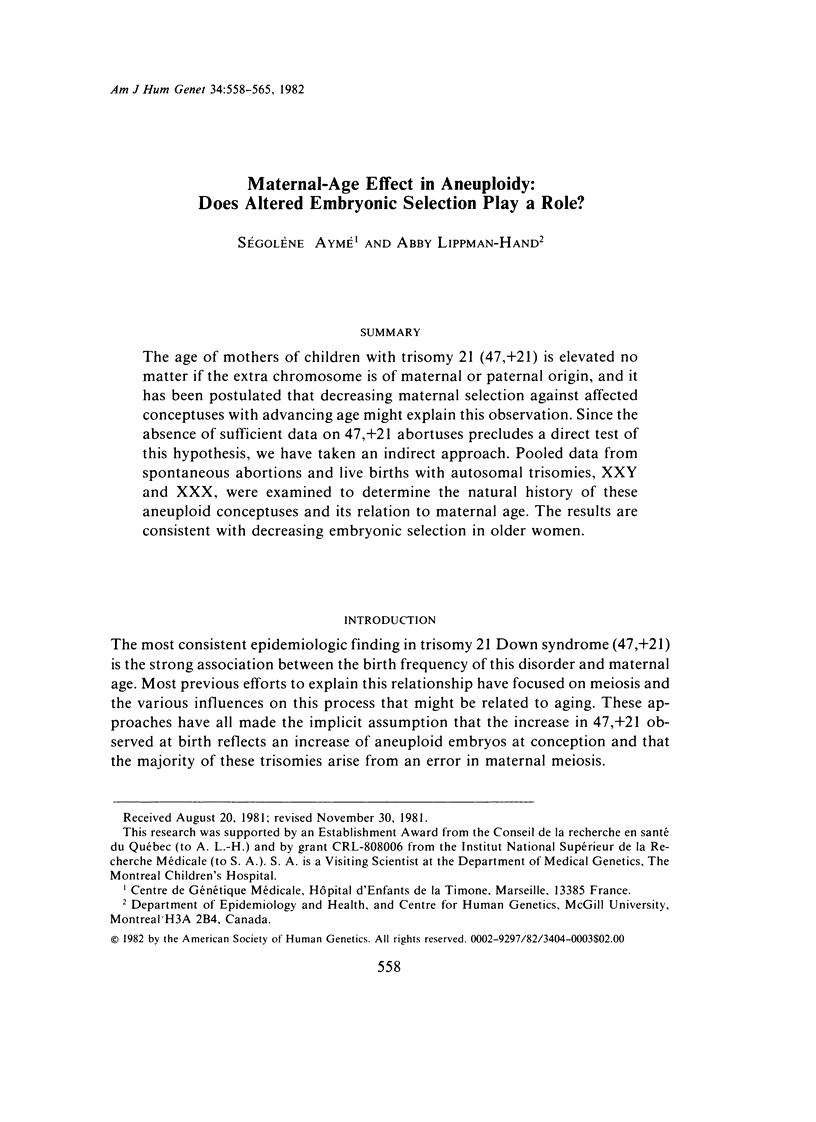Maternal-age effect in aneuploidy: Does altered embryonic selection play a role? (original) (raw)
. 1982 Jul;34(4):558–565.
Abstract
The age of mothers of children with trisomy 21 (47,+21) is elevated no matter if the extra chromosome is of maternal or paternal origin, and it has been postulated that decreasing maternal selection against affected conceptuses with advancing age might explain this observation. Since the absence of sufficient data on 47,+21 abortuses precludes a direct test of this hypothesis, we have taken an indirect approach. Pooled data from spontaneous abortions and live births with autosomal trisomies, XXY and XXX, were examined to determine the natural history of these aneuploid conceptuses and its relation to maternal age. The results are consistent with decreasing embryonic selection in older women.

Selected References
These references are in PubMed. This may not be the complete list of references from this article.
- Buckton K. E., O'Riordan M. L., Ratcliffe S., Slight J., Mitchell M., McBeath S., Keay A. J., Barr D., Short M. A G-band study of chromosomes in liveborn infants. Ann Hum Genet. 1980 Jan;43(3):227–239. doi: 10.1111/j.1469-1809.1980.tb01556.x. [DOI] [PubMed] [Google Scholar]
- Carothers A. D., Collyer S., De Mey R., Frackiewicz A. Parental age and birth order in the aetiology of some sex chromosome aneuploidies. Ann Hum Genet. 1978 Jan;41(3):277–287. doi: 10.1111/j.1469-1809.1978.tb01895.x. [DOI] [PubMed] [Google Scholar]
- Friedrich U., Nielsen J. Chromosome studies in 5,049 consecutive newborn children. Clin Genet. 1973;4(4):333–343. doi: 10.1111/j.1399-0004.1973.tb01928.x. [DOI] [PubMed] [Google Scholar]
- Goad W. B., Robinson A., Puck T. T. Incidence of aneuploidy in a human population. Am J Hum Genet. 1976 Jan;28(1):62–68. [PMC free article] [PubMed] [Google Scholar]
- Hamerton J. L., Canning N., Ray M., Smith S. A cytogenetic survey of 14,069 newborn infants. I. Incidence of chromosome abnormalities. Clin Genet. 1975 Oct;8(4):223–243. doi: 10.1111/j.1399-0004.1975.tb01498.x. [DOI] [PubMed] [Google Scholar]
- Hansson A., Mikkelsen M. The origin of the extra chromosome 21 in Down syndrome. Studies of fluorescent variants and satelite association in 26 informative families. Cytogenet Cell Genet. 1978;20(1-6):194–203. doi: 10.1159/000130851. [DOI] [PubMed] [Google Scholar]
- Hassold T., Jacobs P., Kline J., Stein Z., Warburton D. Effect of maternal age on autosomal trisomies. Ann Hum Genet. 1980 Jul;44(Pt 1):29–36. doi: 10.1111/j.1469-1809.1980.tb00943.x. [DOI] [PubMed] [Google Scholar]
- Hook E. B., Fabia J. J. Frequency of Down syndrome in livebirths by single-year maternal age interval: results of a Massachusetts study. Teratology. 1978 Jun;17(3):223–228. doi: 10.1002/tera.1420170303. [DOI] [PubMed] [Google Scholar]
- Hook E. B., Lindsjö A. Down syndrome in live births by single year maternal age interval in a Swedish study: comparison with results from a New York State study. Am J Hum Genet. 1978 Jan;30(1):19–27. [PMC free article] [PubMed] [Google Scholar]
- Hook E. B. Rates of 47, + 13 amd 46 translocation D/13 Patau syndrome in live births and comparison with rates in fetal deaths and at amniocentesis. Am J Hum Genet. 1980 Nov;32(6):849–858. [PMC free article] [PubMed] [Google Scholar]
- Jacobs P. A., Melville M., Ratcliffe S., Keay A. J., Syme J. A cytogenetic survey of 11,680 newborn infants. Ann Hum Genet. 1974 May;37(4):359–376. doi: 10.1111/j.1469-1809.1974.tb01843.x. [DOI] [PubMed] [Google Scholar]
- Kushnick T. Iummunologic rejection of chromosomally abnormal fetuses. Perspect Biol Med. 1975 Winter;18(2):292–293. doi: 10.1353/pbm.1975.0012. [DOI] [PubMed] [Google Scholar]
- Lubs H. A., Ruddle F. H. Chromosomal abnormalities in the human population: estimation of rates based on New Haven newborn study. Science. 1970 Jul 31;169(3944):495–497. doi: 10.1126/science.169.3944.495. [DOI] [PubMed] [Google Scholar]
- Magenis R. E., Overton K. M., Chamberlin J., Brady T., Lovrien E. Parental origin of the extra chromosome in Down's syndrome. Hum Genet. 1977 Jun 10;37(1):7–16. doi: 10.1007/BF00293766. [DOI] [PubMed] [Google Scholar]
- Mattei J. F., Ayme S., Mattei M. G., Giraud F. Maternal age and origin of non-disjunction in trisomy 21. J Med Genet. 1980 Oct;17(5):368–372. doi: 10.1136/jmg.17.5.368. [DOI] [PMC free article] [PubMed] [Google Scholar]
- Mattei J. F., Mattei M. G., Ayme S., Giraud F. Origin of the extra chromosome in trisomy 21. Hum Genet. 1979 Jan 19;46(1):107–110. doi: 10.1007/BF00278908. [DOI] [PubMed] [Google Scholar]
- Mikkelsen M., Poulsen H., Grinsted J., Lange A. Non-disjunction in trisomy 21: study of chromosomal heteromorphisms in 110 families. Ann Hum Genet. 1980 Jul;44(Pt 1):17–28. doi: 10.1111/j.1469-1809.1980.tb00942.x. [DOI] [PubMed] [Google Scholar]
- Miller J. F., Williamson E., Glue J., Gordon Y. B., Grudzinskas J. G., Sykes A. Fetal loss after implantation. A prospective study. Lancet. 1980 Sep 13;2(8194):554–556. doi: 10.1016/s0140-6736(80)91991-1. [DOI] [PubMed] [Google Scholar]
- Naylor A. F. Sequential aspects of spontaneous abortion: maternal age, parity, and pregnancy compensation artifact. Soc Biol. 1974 Summer;21(2):195–204. doi: 10.1080/19485565.1974.9988106. [DOI] [PubMed] [Google Scholar]
- Nielsen J., Sillesen I. Incidence of chromosome aberrations among 11148 newborn children. Humangenetik. 1975 Oct 20;30(1):1–12. doi: 10.1007/BF00273626. [DOI] [PubMed] [Google Scholar]
- Polani P. E. Chromosome anomalies and abortions. Dev Med Child Neurol. 1966 Feb;8(1):67–70. doi: 10.1111/j.1469-8749.1966.tb08274.x. [DOI] [PubMed] [Google Scholar]
- Roberts D. F., Callow M. H. Origin of the additional chromosome in Down's syndrome: a study of 20 families. J Med Genet. 1980 Oct;17(5):363–367. doi: 10.1136/jmg.17.5.363. [DOI] [PMC free article] [PubMed] [Google Scholar]
- Sergovich F., Valentine G. H., Chen A. T., Kinch R. A., Smout M. S. Chromosome aberrations in 2159 consecutive newborn babies. N Engl J Med. 1969 Apr 17;280(16):851–855. doi: 10.1056/NEJM196904172801602. [DOI] [PubMed] [Google Scholar]
- Stein Z., Susser M., Warburton D., Wittes J., Kline J. Spontaneous abortion as a screening device. The effect of fetal survival on the incidence of birth defects. Am J Epidemiol. 1975 Oct;102(4):275–290. doi: 10.1093/oxfordjournals.aje.a112163. [DOI] [PubMed] [Google Scholar]
- Trimble B. K., Baird P. A. Maternal age and Down syndrome: age-specific incidence rates by single-year intervals. Am J Med Genet. 1978;2(1):1–5. doi: 10.1002/ajmg.1320020102. [DOI] [PubMed] [Google Scholar]
- WARBURTON D., FRASER F. C. SPONTANEOUS ABORTION RISKS IN MAN: DATA FROM REPRODUCTIVE HISTORIES COLLECTED IN A MEDICAL GENETICS UNIT. Am J Hum Genet. 1964 Mar;16:1–25. [PMC free article] [PubMed] [Google Scholar]
- Wagenbichler P., Killian W., Rett A., Schnedl W. Origin of the extra chromosome no. 21 in Down's syndrome. Hum Genet. 1976 Apr 15;32(1):13–16. doi: 10.1007/BF00569971. [DOI] [PubMed] [Google Scholar]